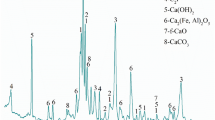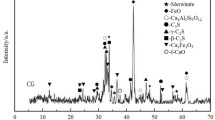Abstract
To enhance the understanding about the utilization of steel slags as a cementitious material, we comparatively studied the chemical, mineralogical and morphological properties of two types of steel slag; basic-oxygen-furnace carbon slag (BOF C) and electric-arc-furnace stainless steel slag (EAF S). Moreover, we studied the standard consistency, setting time and the effect of the slag replacement ratios on the fluidity and compressive strength of blended cement mortar. The experimental results showed that BOF C had higher alkalinity, higher pH value and more hydraulic phases than EAF S. Both types of slag showed water reduction effect due to its high fineness. Neat BOF C paste showed flash set and acceleration in the initial setting time of blended cement especially at high slag proportions. However, EAF S prolonged the setting time of blended cement even at low slag proportions. The pH values for blended cement contained 50% BOF C or EAF S were lower than those of pure cement paste. Despite of slag type, compressive strength gradually decreased with increasing slags content. The strength of BOF C mortar was higher than that of EAF S mortar with the same replacement ratio for the same age. Slag activity index demonstrated that BOF C and EAF S conformed to the Chinese National Standard (GB/T 20491-2006) requirements for steel slag as grade one and grade two, respectively.
Similar content being viewed by others
References
Mineral Commodity Summarizes 2015. US Department of Interior. US Geological Survey[EB/OL]. Available Online: https://doi.org/minerals.usgs.gov/minerals/pubs/mcs/2015/mcs2015.pdf
World Steel Association. Crude Steel Production[EB/OL]. Available Online: https://doi.org/www.worldsteel.org/dms/internetDocumentList/statistics–archive/production–archive/steel–archive/steel–monthly/Steel–monthly–2014/document/Steel%20monthly%202014.pdf
Bin Z, Zhao H W, Jianhua Y, et al. C2 Emission Reduction within Chinese Iron & Steel Industry[J]. Journal of Cleaner Production, 2012, 33: 167–178
Trends in Global C2 Emission: 2014 Report[EB/OL]. Available Online: https://doi.org/www.pbl.nl/sites/default/files/cms/publicaties/PBL_2014_Trends_in_global_CO2_emisions_2014_1490_0.pdf
Cement Technology Road Map 2009. Carbon Emission Reductions up to 2050. World Business Council for Sustainable Development and International Energy Agency[EB/OL]. Available Online: https://doi.org/www.worldsteel.org/publications/position-papers/Steel-s-contribution-to-alow-carbon-future.html
Qiang W, PeiYu Y, Song H. The Influence of Steel Slag on the Hydration of Cement during the Hydration Process of Complex Binder[J]. Science China Technological Sciences, 2011, 54(2): 388–394
HuangY, Guoping X, Huigao C, et al. An Overview of Utiization of Steel Slag. The 7th International Conference on Waste Management and Technology[J]. Procedia Environmental Sciences, 2012, 16: 791–801
Zhu G, Hao Y, Xia C, et al. Study on Cementitious Properties of Steel Slag[J]. Journal of Mining and Metallurgy Section B–metallurgy, 2013, 49(2): 217–224
Yeong NS, Her YW, Te HS. A Study of Engineering Properties of Cement Mortar with Stainless Steel Oxidizing Slag and Reducing Slag Resource Materials[J]. Construction and Building Materials, 2013, 40: 239–245
Mason B. The Constitution of Some Open Heart Slag[J]. Journal of Iron and Steel Institute, 1994, 11(1): 69–80
Tossavainen M, Engstrom F, Yang Q, et al. Characteristics of Steel Slag under Different Cooling Conditions[J]. Waste Management, 2007, 27: 1 335–1 344
Muhammad S, Özlem C, Yiannis P, et al. Effect of Curing Temperatures on the Alkali Activation of Crystalline Continuous Casting Stainless Steel Slag[J]. Construction and Building Materials, 2014, 71: 308–316
Tang M. An Investigation on Mineral Composition of Steel Slag for Cement Production[R]. Nanjing institute of chemical technology, Nanjing, china, 1973
Hasan A, Mustafa C, Muharrem Y, et al. Concrete Produced by Steel–making Slag (Basic oxygen furnace) Addition in Portland Cement [J]. International Journal of Applied Ceramic Technology, 2009, 6(6): 736–748
Taylor H. Cement Chemistry[M]. 2st ed. London: Thomas Telford Publishing; Hand book, 1997
Currell BR, et al. The Acceleration and Retardation of Set High Alumina Cement by Additives[J]. Cement and Concrete Research, 1987, 17(3): 420–432
Mark W, Maciej Z, Mohsen BH, et al. The Role of the Alumina Content of Slag, Plus the Presence of Additional Sulfate on the Hydration and Microstructure of Portland Cement–slag Blends Original[J]. Cement and Concrete Research, 2014, 66: 91–101
Alexandra Q, Karen LS. Hydration of C3A–gypsum Systems[J]. Cement and Concrete Research, 2012, 42(7): 1 032–1 041
Craig WH, Ana PK, Paulo JM, et al. Early Age Hydration of Calcium Sulfoaluminate in the Presence of Gypsum and Varying Amounts of Calcium Hydroxide[J]. Cement and Concrete Research, 2013, 48: 105–115
Kourounis S, Tsivilis S, Tsakiridis PE, et al. Propertiesand Hydration of Blended Cements with Steelmaking Slag[J]. Cement and Concrete Research, 2007, 37(6): 815–22
Qiang W, Bo Z, PeiYu Y. The Influence of Steel Slag with High Al2O3 Content on the Initial Hydration of Cement[J]. Science China Technological Science, 2013, 56(12): 3 123–3 128
Wei S, Yunsheng Z, Sifeng L, et al. The Influence of Mineral Admixture on Resistance to Corrosion of Steel Bars of Green High–performance Concrete[J]. Cement and Concrete Research, 2004, 34(10): 1 781–1 785
GB/T 20491–2006. Chinese National Standard Test Method of Steel Slag Used for Cement and Concrete[S].
ASTM C187–11e. Standard test Method for Amount of Water Required for Normal Consistency of Hydraulic Cement Paste[S].
GB175–2007. Chinese National Standard Test Method for Common Portland Cement[S].
ASTM C191–08. Standard Test Methods for Time of Setting of Hydraulic Cement by Vicat Needle[S].
ASTM C1437–15. Standard Test Method for Flow Table of Hydraulic Cement Mortar[S].
GB/T 17671–1999. Chinese National Standard Test Method of Testing Cements–determination of Strength[S].
Author information
Authors and Affiliations
Corresponding author
Additional information
Funded by the National Natural Science Foundations of China ( Nos. 51378113 and 51438003), the Plan of Six Peak Talents in Jiangsu Province (No. JZ-004), and Partly Supported by the National Basic Research Program of China (973 Program, No. 2015CB655102)
Rights and permissions
About this article
Cite this article
Saly, F., Guo, L., Ma, R. et al. Properties of Steel Slag and Stainless Steel Slag as Cement Replacement Materials: A Comparative Study. J. Wuhan Univ. Technol.-Mat. Sci. Edit. 33, 1444–1451 (2018). https://doi.org/10.1007/s11595-018-1989-3
Received:
Accepted:
Published:
Issue Date:
DOI: https://doi.org/10.1007/s11595-018-1989-3




